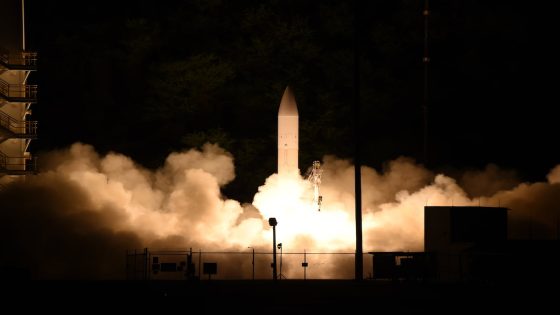The U.S. Army is aiming for one more major test of its Long-Range Hypersonic Weapon by the end of 2024 in order to decide whether to field it to the first unit next year, Doug Bush, the serviceâs acquisition chief, said Thursday.
The Common Hypersonic Glide Body, which is the all-up round developed jointly with the U.S. Navy, conducted a key successful test earlier this year. The Navy will integrate the round into a ship-launched capability, while the Army will integrate it into a ground launcher.
The Army has worked with Leidosâ Dynetics for years to build the industrial base for the Common Hypersonic Glide Body that will be used by both the ground service and the Navy, as the domestic private sector has never built a hypersonic weapon.
On the heels of the Navy test, âwhat weâve got to do is make sure we have a full end-to-end test as close to an operational test that is successful,â Bush told reporters in a Pentagon briefing.
The Army needs to have confidence âitâs safe and effective to actually put in a unit that might have to go to war,â he said. âWe havenât had that test event yet where itâs fully succeeded, but weâre going to have, hopefully have, it this year.â
If the service is able to pull off a successful test, then it will be on track to field it to the first unit as an initial operational capability, according to Bush.
The Army completed its delivery of the first hypersonic weapon capability â minus the all-up rounds â to the 1st Multidomain Task Force 5th Battalion, 3rd Field Artillery Regiment, 17th Field Artillery Brigade unit at Joint Base Lewis-McChord, Washington, two days ahead of its end-of-fiscal 2021 fielding deadline.
Hypersonic weapons are capable of flying faster than Mach 5 â or more than 3,836 miles per hour â and can maneuver between varying altitudes, making them difficult to detect. The C-HGB is made up of the weaponâs warhead, guidance system, cabling and thermal protection shield.
The U.S. is in a race to field the capability and develop systems to defend against hypersonic missiles. China and Russia are actively developing and testing hypersonic weapons.
In August, Lt. Gen. Robert Rasch, Rapid Capabilities and Critical Technologies Office director, told Defense News in an exclusive interview at the Space and Missile Defense Symposium in Huntsville, Alabama, that the Army is âreally closeâ to fielding the capability. But he cautioned that more testing remains before any decision is made on the future of its ground-launched hypersonic missile.
The Navyâs flight test of the industry-manufactured missile â which took place at the Pacific Missile Range Facility in Hawaii in May â was highly anticipated as part of the joint development program following a series of failed or aborted tests of the Common Hypersonic Glide Body.
The Army and Navy last year had to abort flight tests in March, October and November due to challenges at the range related not to the round but the process of firing up the missile for launch.
Missile development programs typically take about 10 years, Rasch stressed, and while the plan to field hypersonic missiles to a first unit has been delayed by over a year, the Long-Range Hypersonic Weapon program is only at the five-year mark.
âWeâve got to make sure this capability works. If the decision is made to implement this, itâs for real, serious reasons, strategic-level reasons, and we need it to work every time,â Rasch said.
Jen Judson is an award-winning journalist covering land warfare for Defense News. She has also worked for Politico and Inside Defense. She holds a Master of Science degree in journalism from Boston University and a Bachelor of Arts degree from Kenyon College.
Source Agencies


